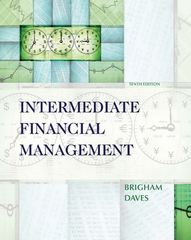Question
Bond valuation and yield to maturity Mark Goldsmith's broker has shown him two bonds. Each has a maturity of 5 years, a par value of
Bond valuation and yield to maturity Mark Goldsmith's broker has shown him two bonds. Each has a maturity of 5 years, a par value of $1,000, and a yield to maturity of 12%. Bond A has a coupon interest rate of 6% paid annually. Bond B has a cou pon interest rate of 14% paid annually.
a. Calculate the selling price for each of the bonds.
b. Mark has $20,000 to invest. Judging on the basis of the price of the bonds, how many of either one could Mark purchase if he were to choose it over the other?
(Mark cannot really purchase a fraction of a bond, but for purposes of this question, pretend that he can.)
c. Calculate the yearly interest income of each bond on the basis of its coupon rate and the number of bonds that Mark could buy with his $20,000.
d. Assume that Mark will reinvest the interest payments as they are paid (at the end of each year, and that his rate of return on the reinvestment is only 10%. For each bond, calculate the value of the principal payment plus the value of Mark's reinvestment account at the end of the 5 years.
e. Why are the two values calculated in part d different? If Mark were worried that he would earn less than the 12% yield to maturity on the reinvested interest pay ments, which of these two bonds would be a better choice?
Step by Step Solution
There are 3 Steps involved in it
Step: 1

Get Instant Access to Expert-Tailored Solutions
See step-by-step solutions with expert insights and AI powered tools for academic success
Step: 2

Step: 3

Ace Your Homework with AI
Get the answers you need in no time with our AI-driven, step-by-step assistance
Get Started


